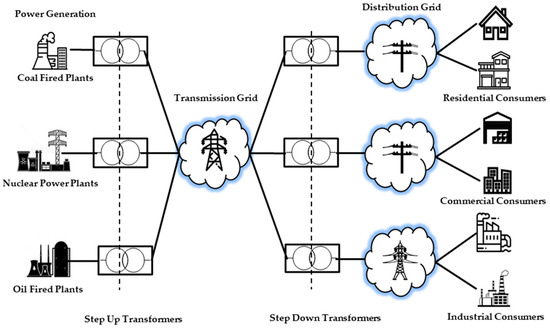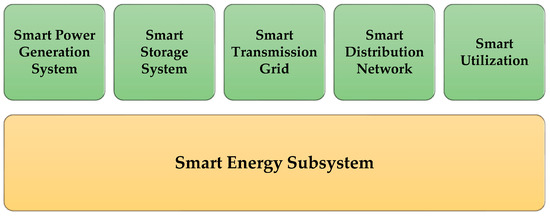You're using an outdated browser. Please upgrade to a modern browser for the best experience.
Please note this is a comparison between Version 1 by Hafiz Abd ul Muqeet and Version 2 by Sirius Huang.
A smart grid (SG), considered as a future electricity grid, utilizes bidirectional electricity and information flow to establish automated and widely distributed power generation. The SG provides a delivery network that has distributed energy sources, real-time asset monitoring, increased power quality, increased stability and reliability, and two-way information sharing.
- smart grid
- bidirectional communication
- controllers
- distributed energy resources
1. Introduction
The electricity grid is a network that generates, transmits, distributes and controls electric power. The traditional power grid mainly has a central generation system, limited control over frequency and voltage, a central control, limited grid status monitoring and a manual distribution system with the absence of a smart load. Smart Grid (SG) is a developed or smart form of the conventional grid having a bidirectional flow of information and electricity, creating an automated and highly advanced energy supply system [1].
A SG delivers energy more efficiently, facilitates enhanced customer utility interaction, provides pervasive voltage control, reliable frequency control, modern management techniques and responds to wide-ranged events occurring in the system [2]. For example, in response to the failure of a distribution feeder or transformer, the SG automatically recovers the power flow to load using its self-healing capability [3][4][5][6][3,4,5,6]. Similarly, the grid automatically responds to overloading or injection of the distributed generator [7]. Considering another example of customer load shaping through smart meters, this load shaping reduces the peak demand on the power system, as well as energy bills [8]. Reduction in load triggers a chain of benefits, such as energy loss minimization, smoothing of load on the network and reduction in capital investment on the system [9][10][11][9,10,11].
2. Smart Energy Subsystem
The SG has bi-directional information and electricity flow, unlike the conventional grid. The smart infrastructure system consists of a smart energy subsystem, a smart communication subsystem, and a smart information subsystem. The conventional power grid has been unidirectional [12][63]. The electrical system historically has been central. The power produced by hydro and thermal generators is increased from 11.5 kV to 220/500/700/1000 kV and injected in the central power pool of an extra high voltage (EHV) transmission corridor (primary transmission grid). Power flows to long distances at this EHV medium. The switchyard in service for increasing the power is called the primary transmission grid station. Power enters the secondary transmission grid station where it decreases to the 138/132/66 kV level and is injected into a secondary transmission grid (network). High voltage secondary transmission lines feed the primary voltage distribution substations that decrease the voltage from 132 kV and 66 kV to 11.5 kV. At this juncture, voltage leaves the transmission grid and enters the distribution grid. The distribution grid consists of 11.5 kV networks called the primary distribution grid which ends at the pad-mounted or pole-mounted transformer (secondary distribution substation (SDS)). The secondary distribution grid emanates from the SDS and carries voltage at a 440 V, three-phase, four-wire, star-connected system. Figure 13 shows a traditional power grid. The central power system suffers from many problems. If any type of instability occurs, such as angle, frequency or voltage instability, it can spread to all parts of the power system, resulting in a national blackout. Additionally, the transmission network proves a bottleneck to route centralized generation resulting in overloading of transmission media, energy losses, and performance degradation.
Figure 13.
Traditional energy grid.

Figure 24.
Smart energy subsystem.
2.1. Smart Power Generation System
Smart power generation system consists of conventional electricity sources integrated with digital communication technologies. Wind and solar energies are renewable energy resources (RERs) of electricity. Power generation from RERs for Brazil, OECD and other parts of the world is presented in [13][64]. Fossil fuels pollute the atmosphere, get depleted and become expensive with time. The running cost of fossil fuels is very high. However, coal is the only option that is relatively cheaper in power production. Hydroelectricity sources also have problems. Large reservoir dams take too much time and money to construct. Such projects have environmental consequences in the form of waterlogging, turning the surrounding land into barren land. The run-of-river projects does not require significant capital cost and construction time [14][65]. It can be suggested that coal-fired steam power plants and the small run-of-river projects are two types of power sources that require less construction time, less capital and operational costs. Developing countries, having an acute shortage of electricity and soaring per unit price, can use this strategy as a possible short-term low-priced solution [15][66]. Unfortunately, however, the power sector has been hijacked by a power generation mafia controlled by independent power producers (IPPs) that hinder such steps toward cheap electricity generation [16][67]. To survive the power sector in developing countries, its dependence on thermal power-producing IPPs must be reduced. It must opt small hydro- and coal-based projects in the short term and large-scale reservoir type dams in the long term with more penetrations of RERs.2.2. Smart Storage System
In SG environment, RERs reduce the dependence on conventional generation sources but they are extremely fluctuant. The unpredictable nature of RERs can even jeopardize the grid stability; therefore, more robust controllers and an enhanced transient and dynamic stability of the system would be required. Modelling RERs is a challenge due to their stochasticity [17][68]. Energy storage systems are commonly employed to tackle the fluctuant renewables [18][19][20][21][69,70,71,72]. Various high-performance batteries such as Li-ion, super capacitors, and flywheels have been widely used. Authors of [20][71] presented a review on Super capacitor based hybrid energy storage system for photovoltaic (PV) integration. Authors of [17][68] presented economic and environmental benefits of energy storage for a prosumer microgrid. H.A. Muqeet et al. [21][72] presented cost benefits of battery-based energy storage systems in SG environment where consumer can exchange its surplus energy with grid network. Authors in [18][69] studied life degradation impacts of battery storage for an islanded microgrid. A comprehensive review of modern storage trends for EV charging stations is presented in [4]. The power electronic systems play a pivotal role while integrating renewable and energy storage in SG [19][70]. In [22][73], the authors review power quality issues associated with intermittent power source integration in the electrical network and point out the effects of electronic devices, such as transistors, diodes and flexible AC transmission systems (FACTs), on such problems. Solar and wind power penetration challenges are discussed. Bhutto et al. [23][74] identified both the challenges and progress for PV energy and the area-wise potential of PV energy and its existing status. Small scale hydro (1–30 MW) and run-of-the-river micro-hydro plants (1–100 kW) can play a great role. Their construction requires less time and money, and they can consequently play a vital role in bringing cheap electricity within a smaller period. Unfortunately, this water gets wasted due to the absence of large dams. The construction of reservoir-type dams has been politicized. Under such circumstances, many small and micro-hydroelectric plants can be installed along the rivers and canals to meet the country’s dire need of energy [24][75]. However, the importance of reservoir-type dams cannot be overlooked as they play a pivotal role in bringing cheap energy in the long run.2.3. Smart Transmission System
This grid is responsible of carrying power to long distances. Real challenges are quickly ageing components, ever-increasing demand infrastructure and the use of enabling technologies to modernize the grid. A healthy transmission grid is extremely crucial in maintaining system stability. The smart transmission grid consists of three parts: the smart control center, the smart power transmission network, and the smart substation [25][76]. The future smart control centers enable new features, such as metering and grid status-related data collection through meters, sensors and communication channels, analytical capabilities for analysis and state estimation, status monitoring of grid, and visualization [26][77]. The smart transmission network is the advancement of the existing network by adding sensors, communication technologies, computational engines, and signal processors that can bring improvement in energy use, power quality, system reliability, and security. The basic structure of a high-voltage substation did not alter with time, but the system monitoring, measurement, and controllers changed [27][78]. Advancements of a smart substation include data metering and transmission, state estimation, visualization, digitalization of displays, automated functioning, coordination, and self-healing.2.4. Smart Distribution Network
The distribution grid serves the end-users; therefore, its importance in rendering quality service is quite high. The distribution system will have DER(s) that make the system more flexible, stable, qualitative and efficient, but make power flow more complicated. In [28][79], Takano et al. presented two domestic energy distribution systems that distribute electricity by the information added to the energy. The first proposed setup is a circuit switching system based primarily on the alternating current (AC) power distribution, whereas the other is a direct current (DC) power distribution system through energy packets. Power packetization is a challenging but interesting method, based on high power switching devices. It is proved that silicon carbide junction gate field-effect transistors can provide packets of electric power [29][80]. The authors in [28][79] discussed an intelligent power router which divides energy into packets. Headers and footers are linked with an energy unit to create a power packet. At the receiving side, each packet is steered by a router to the address described in the header and then dispatched to the concerned load, making in-house power delivery efficient. The major purpose of distribution automation is real-time adjustments to changing loads, control over generation connected to the power distribution system, switching, self-healing or recovery during a fault or abnormal conditions and automatic energy flow control without operator involvement. This necessitates control of field devices through central or distributed control. Information gathered from meters and its transmission to controllers is realized by the communication medium.2.5. Smart Utilization
In the SG, the utilization sector is very important. Different entities such as the prosumer [17][21][68,72], demand responsive smart homes, smart buildings [11][15][11,66], flexible loads, etc. provide smart features in power utilization. The energy management system is used to manage the available energy by demand response and various techniques [2][30][31][2,14,19]. Meanwhile the smart energy storage system plays vital role in smart utilization. Different types of storage systems are used to store the energy as backup. This stored energy is used for various purposes, such as energy arbitrage, energy exchange program, and power system stability purposes [32][81].2.6. Prominent Features of Smart Grids
This section will discuss three new grid paradigms, namely microgrid, vehicle-to-grid (V2G) and grid-to-vehicle (G2V). (1) Microgrid: Distributed generation gives a cornerstone idea of the SG called microgrid [33][82]. The SG has the plug-and-play interconnection of small microgrids [12][63]. A microgrid is a group of generators, storage, and customers [34][83]. The microgrid can run in either coupled mode with a macro–grid or islanded mode. In the first mode, it can feed extra power to the macro-grid, or it can take power from a macro-grid. In the second mode, it serves its load in isolation with the macro-grid. A microgrid can be disconnected at the point of common coupling from the macro-grid working independently. Figure 35 shows a microgrid.
Figure 35.
Different layers of a microgrid.
-
The EV produces energy from stored fuel and generates electric power from the generator for an electric company at peak hours. Such vehicles can act as a distributed energy source.
-
An EV supplying power to the grid uses a rechargeable battery during peak electricity hours. EVs recharge back at cheap rates in off-peak hours. Such a vehicle fleet acts as DGs increasing system reliability.
-
Solar vehicles can use excess charging to provide energy to the electric network. These types of vehicles act as small distributed renewable energy sources.
